Popular categories
Looking for a yarn?

75% Wool, 25% Polyamide
from 2.50 € /50g
Order DROPS Kid-Silk from Trgovinca iNCA

|
DROPS Kid-Silk uni colour 75% Mohair, 25% Silk |
5.05 € /25g |
Order |
Clicking the ORDER button will redirect you to Trgovinca iNCA website
The yarn cost is calculated from the pattern’s smallest size and the yarn’s cheapest product type. Looking for an even better price? You might find it on the DROPS Deals!
Fairytale
Knitted vest in 1 strand DROPS Fabel and 1 strand Kid-Silk. The piece is worked bottom up with diagonal shoulders. Sizes S - XXXL.
DROPS Design: Pattern fa-521
Yarn group A + A or C
-------------------------------------------------------
SIZES:
S - M - L - XL - XXL - XXXL
MATERIALS:
DROPS FABEL from Garnstudio (belongs to yarn group A)
150-150-150-200-200-200 g colour 922, fruit patch
And use:
DROPS KID-SILK fra Garnstudio (belongs to yarn group A)
75-75-75-75-75-100 g colour 22, ash grey
NEEDLES:
DROPS CIRCULAR NEEDLE SIZE 5 MM: Length 80 cm.
DROPS CIRCULAR NEEDLE SIZE 4 MM: Length 40 cm and 80 cm.
The technique MAGIC LOOP can be used – you then only need circular needle of 80 cm in each size.
KNITTING TENSION:
17 stitches in width and 22 rows in height with stocking stitch = 10 x 10 cm.
NOTE: Needle size is only a guide. If you get too many stitches on 10 cm, change to a larger needle size. If you get too few stitches on 10 cm, change to a smaller needle size.
-------------------------------------------------------
Alternative Yarn – See how to change yarns here
Yarn Groups A to F – Use the same pattern and change the yarn here
Yarn usage using an alternative yarn – Use our yarn converter here
-------------------------------------------------------

75% Wool, 25% Polyamide
from 2.50 € /50g
Order DROPS Fabel from Trgovinca iNCA

|
DROPS Kid-Silk uni colour 75% Mohair, 25% Silk 5.05 € /25g Order |
Clicking the ORDER button will redirect you to Trgovinca iNCA website
The yarn cost is calculated from the pattern’s smallest size and the yarn’s cheapest product type. Looking for an even better price? You might find it on the DROPS Deals!
- English (UK/cm), Slovenia
- Česky
- Dansk
- Deutsch
- Eesti keel
- English (UK/cm)
- English (US/in)
- Español
- Français
- Íslenska
- Italiano
- Magyar
- Nederlands
- Norsk
- Polski
- Português
- Suomi
- Svenska
- English (UK/cm), Bulgaria
- English (UK/cm), Croatia
- English (UK/cm), Greece
- English (UK/cm), Latvia
- English (UK/cm), Lithuania
- English (UK/cm), Romania
- Česky, Slovakia
Pattern instructions
EXPLANATIONS FOR THE PATTERN:
-------------------------------------------------------
RIDGE/GARTER STITCH (worked back and forth):
Knit all rows.
1 ridge = knit 2 rows.
-------------------------------------------------------
START THE PIECE HERE:
-------------------------------------------------------
VEST – SHORT OVERVIEW OF THE PIECE:
The front and back pieces are worked separately back and forth, bottom up. The back piece is 2 cm longer than the front. The sleeve-edges and neck are worked in the round to finish.
BACK PIECE:
Cast on 88-96-104-112-120-132 stitches with circular needle size 4 mm and 1 strand DROPS Fabel and 1 strand DROPS Kid-Silk (2 strands). Purl 1 row from the wrong side.
Work rib from the right side as follows: 1 stitch in GARTER STITCH – read description above, work rib (knit 2, purl 2) until there are 3 stitches left, knit 2 and 1 stitch in garter stitch.
Continue this rib for 4 cm.
Change to circular needle size 5 mm. Continue with stocking stitch; on the first row decrease 14-14-16-16-14-16 stitches evenly spaced = 74-82-88-96-106-116 stitches.
Work until the piece measures 19-20-21-22-23-24 cm. REMEMBER THE KNITTING TENSION!
On the next row begin to cast off for the armholes on both sides: 3-3-3-4-4-4 stitches 1 time, 2 stitches 1 time and 1 stitch 1-3-4-6-9-12 times = 62-66-70-72-76-80 stitches. Continue working until the piece measures 42-44-46-48-50-52 cm (4 cm left to finished length). On the next row cast off the middle 26-26-28-28-30-30 stitches for the neck and finish each shoulder separately.
OVERVIEW OF THE NEXT SECTION:
You now cast off for the neck and place stitches on a thread for the diagonal shoulder. Read NECK and DIAGONAL SHOULDER before continuing.
NECK:
Cast off 1 stitch at the beginning of the next row from the neck.
DIAGONAL SHOULDER:
Place the stitches towards the armhole on a thread; to avoid having to cut the strand, work the stitches first. Place 4-5-5-5-6-6 stitches on the thread 3 times then the remaining 5-4-5-6-4-6 stitches. All stitches are now either cast off or on the thread.
Place the 17-19-20-21-22-24 stitches from the thread back on circular needle size 5 mm. Purl 1 row from the wrong side. To avoid holes where you turned, pick up the strand between 2 stitches and purl it twisted together with the next stitch on the left needle. Cast off with knit, a little loosely, from the right side. The piece measures approx. 46-48-50-52-54-56 cm from the cast-on edge to the highest point on the shoulder.
Work the other shoulder in the same way.
FRONT PIECE:
Cast on and work as the back until the front piece measures 17-18-19-20-21-22 cm.
On the next row begin to cast off for the armholes on both sides: 3-3-3-4-4-4 stitches 1 time, 2 stitches 1 time and 1 stitch 1-3-4-6-9-12 times = 62-66-70-72-76-80 stitches. Continue working until the piece measures 34-36-36-38-38-40 cm (approx. 10-10-12-12-14-14 cm left to finished length). On the next row from the right side place the middle 12-12-14-14-16-16 stitches on a thread for the neck and finish each shoulder separately.
OVERVIEW OF THE NEXT SECTION:
You now cast off for the neck and place stitches on a thread for the diagonal shoulder. Read NECK and DIAGONAL SHOULDER before continuing.
NECK:
Cast off from the neck 2 stitches 2 times and 1 stitch 4 times.
DIAGONAL SHOULDER:
AT THE SAME TIME, when the piece measures 41-43-45-47-49-51 cm place the stitches towards the armhole on a thread in the same way as on the back piece. When all the stitches are either cast off or on the thread, place the 17-19-20-21-22-24 stitches from the thread back on circular needle size 5 mm. Purl 1 row from the wrong side in the same way as on the back. Cast off a little loosely with knit from the right side. The piece measures approx. 44-46-48-50-52-54 cm from the cast-on edge to the highest point on the shoulder.
Work the other shoulder in the same way.
ASSEMBLY:
Sew the shoulder seams edge to edge. Sew the side seams edge to edge, starting from the armholes and sewing to 1 cm after the beginning of the rib, leaving a split; the back piece is longer than the front.
NECK:
Start from the right side on one shoulder, with 1 strand Fabel and 1 strand Kid-Silk. Using short circular needle size 4 mm knit up 80 to 100 stitches (including the stitches on the thread) around the neck. Stich-number should be divisible by 4. Work rib in the round (knit 2, purl 2) for 4 cm. Cast off with knit over knit and purl over purl.
SLEEVE-EDGES:
Start from the right side at the bottom of the armhole with 1 strand Fabel and 1 strand Kid-Silk. Using short circular needle size 4 mm knit up 112 to 136 stitches around the armhole (Stich-number should be divisible by 4). Work rib in the round (knit 2, purl 2) for 4 cm. Cast off with knit over knit and purl over purl.
Work the other sleeve-edge in the same way. The edge can be folded double to the inside for a narrower but thicker sleeve-edge.
Diagram

What can you do with our patterns? You can share DROPS patterns online, using the pattern original picture, materials, name and number. But you are NOT ALLOWED to reproduce the complete pattern digitally in any way. Yarn stores are welcome to use the DROPS pattern database to promote the sale of our assortment. You can print out our patterns, make as many copies as you’d like. The only thing we ask is that you don't make any changes / additions to the original printed document. And that the patterns according to the DROPS philosophy are given out to the consumers for free. Editorials that wish to publish our patterns in printed books or magazines can contact us for more information. The sale of garments based on DROPS patterns is permitted as long as they are sold as single items or per order. Further commercial use of the patterns is not permitted. It has to be clearly stated that the garment is made based on a design from DROPS DESIGN. The use of clothing labels of which DROPS DESIGN forms part is conditioned by the inclusion of the following text: “A DROPS DESIGN made by …..”. The use of DROPS photos for marketing purposes/sales is only permitted in connection with the use/sale of DROPS products. The photos may not be cut or edited and the logo should be clearly visible.
We reserve the right to withdraw the permission for use of our patterns at any time, notwithstanding the reason.
Each of our patterns has specific tutorial videos to help you.
These step-by-step tutorials might also help you:
Why is the knitting/crochet tension so important?
Knitting tension is what determines the final measurements of your work, and is usually measured per 10 x 10 cm. It is provided like so: number of stitches in width x number of rows in height - eg: 19 stitches x 26 rows = 10 x 10 cm.
The knitting tension is very individual; some people knit/crochet loosely while others work tightly. You adjust the knitting tension with the needle size, which is why the suggested needle size is only meant as a guide! You need to adjust this (up or down) to ensure that YOUR knitting tension matches the knitting tension provided in the pattern. If you work with a different knitting tension than provided you will have a different yarn consumption, and your work will have different measurements than what the pattern suggests.
The knitting tension also determines which yarns can replace each other. As long as you achieve the same knitting tension you can replace one yarn with another.
See DROPS lesson: How to measure your tension/gauge
See DROPS video: How to make a gauge tension swatch
How do I know how many balls of yarn I need?
The required amount of yarn is provided in grams, eg: 450 g. To calculate how many balls you’ll need you first need to know how many grams are in 1 ball (25g, 50g or 100g). This information is available if you click on the individual yarn quality on our pages. Divide the amount required with the amount of each ball. For example, if each ball is 50g (the most common amount), the calculation will be as follows: 450 / 50 = 9 balls.
Can I use a different yarn than what the pattern suggests?
The important thing when changing from one yarn to another is that the knitting/crochet tension remains the same. This is so that the measurements of the finished piece will be the same as on the sketch provided. It is easier to achieve the same knitting tension using yarns from the same yarn group. It is also possible to work with multiple strands of a thinner yarn to achieve the knitting tension of a thicker one. Please try our yarn converter. We recommend you to always work a test swatch.
Please NOTE: when changing yarn the garment might have a different look and feel to the garment in the photo, due to individual properties and qualities of each yarn.
See DROPS lesson: Can I use a different yarn than the one mentioned in the pattern?
What are the yarn groups?
All our yarns are categorised into yarn groups (from A to F) according to thickness and knitting tension – group A contains the thinnest yarns and group F the thickest. This makes it easier for you to find alternative yarns to our patterns, should you wish to switch yarn. All yarns within the same group have a similar knitting tension and can easily replace each other. However, different yarn qualities have different structures and properties which will give the finished work a unique look and feel.
How do I use the yarn calculator?
At the top of all our patterns you’ll find a link to our yarn calculator, which is a helpful tool should you wish to use a different yarn than suggested. By filling in the yarn quality you wish to replace, the amount (in your size) and number of strands, the calculator will present good alternative yarns with the same knitting tension. Additionally it will tell you how much you’ll require in the new qualities and whether you’ll need to work with multiple strands. Most skeins are 50g (some are 25g or 100g).
If the pattern is worked with multiple colours, every colour will have to be calculated separately. Similarly, if the pattern is worked with several strands of different yarns (for example 1 strand Alpaca and 1 strand Kid-Silk) you will have to find alternatives for each, individually.
Why do you show discontinued yarns in the patterns?
Since different yarns have different qualities and textures we have chosen to keep the original yarn in our patterns. However, you can easily find options among our available qualities by using our yarn calculator, or simply pick a yarn from the same yarn group.
It is possible that some retailers still have discontinued yarns in stock, or that someone has a few skeins at home that they would like to find patterns for.
The yarn calculator will provide both alternative yarn as well as required amount in the new quality.
What size should I knit?
If you think it's hard to decide what size to make, it can be a good idea to measure a garment you own already and like the size of. Then you can pick the size by comparing those measures with the ones available in the pattern's size chart.
You'll find the size chart at the bottom of the pattern.
See DROPS lesson: How to read size chart
Why do I get the wrong knitting tension with the suggested needle size?
The needle size provided in the pattern serves only as a guide, the important thing is to follow the knitting tension. And since knitting tension is very individual, you will have to adjust the needle size to ensure that YOUR tension is the same as in the pattern – maybe you’ll have to adjust 1, or even 2 needle sizes, up or down to achieve the correct tension. For this, we recommend that you work test swatches.
Should you work with a different knitting tension than the one provided, the measurements of the finished garment might deviate from the measurement sketch.
See DROPS lesson: How to measure your tension/gauge
See DROPS video: How to make a tension/gauge swatch
Why is the pattern worked top-down?
Working a garment top-down provides more flexibility and room for personal adjustment. For example it is easier to try the garment on while working, as well as making adjustments to length of yoke and shoulder caps.
The instructions are carefully explaining every step, in the correct order. Diagrams are adjusted to the knitting direction and are worked as usual.
How do I work according to a knitting diagram?
The diagram depicts all rows/rounds, and every stitch seen from the right side. It is read from bottom to top, from right to left. 1 square = 1 stitch.
When working back and forth, every other row is worked from the right side and every other row is worked from the wrong side. When working from the wrong side, the diagram will have to be worked reversed: from left to right, knit stitches are purled, purl stitches are knit etc.
When working in the round every round is worked from the right side and the diagram are worked from right to left on all rounds.
See DROPS lesson: How to read knitting diagrams
How do I work according to a crochet diagram?
The diagram depicts all rows/rounds, and every stitch seen from the right side. It is worked from bottom to top, from right to left.
When working back and forth every other row is worked from the right side: from right to left and every other row is worked from the wrong side: from left to right.
When working in the round, every row in the diagram are worked from the right side, from right to left.
When working a circular diagram you start in the middle and work your way outwards, counter clockwise, row by row.
The rows usually start with a given number of chain stitches (equivalent to the height of the following stitch), this will either be depicted in the diagram or explained in the pattern.
See DROPS lesson: How to read crochet diagrams
How do I work several diagrams simultaneously on the same row/round?
Instructions for working several diagrams after each other on the same row/round, will often be written like so: “work A.1, A.2, A.3 a total of 0-0-2-3-4 times". This means you work A.1 once, then A.2 is worked once, and A.3 is repeated (in width) the number of times provided for your size – in this case like so: S = 0 times, M = 0 times, L=2 times, XL= 3 times and XXL = 4 times.
The diagrams are worked as usual: begin with the first row in A.1, then work the first row in A.2 etc.
See DROPS lesson: How to read knitting diagrams
See DROPS lesson: How to read crochet diagrams
Why are the sleeves shorter in larger sizes?
The total width of the garment (from wrist-to-wrist) will be larger in the larger sizes, despite the actual sleeves being shorter. The larger sizes have longer sleeve caps and wider shoulders, so there will be a good fit in all sizes.
Where on the garment is the length measured?
The measurement sketch/schematic drawing provides information regarding the full length of the garment. If it’s a jumper or a jacket the length is measured from the highest point on the shoulder closest to the neckline, and straight down to the bottom of the garment. It is NOT measured from the tip of shoulder. Similarly, the length of yoke is measured from the highest point on the shoulder and down to where yoke is split into body and sleeves.
On a jacket measures are never taken along bands, unless specifically stated. Always measure inside band stitches when measuring the length.
See DROPS lesson: How to read a schematic drawing
What is a repeat?
Diagrams are often repeated on the round or in height. 1 repeat is the diagram the way it appears in the pattern. If it says to work 5 repeats of A.1 in the round, then you work A.1 a total of 5 times after/next to each other in the round. If it says to work 2 repeats of A.1 vertically/in height you work the entire diagram once, then begin again at the start and work the entire diagram one more time.
Why does the piece start with more chain stitches than it’s worked with?
Chain stitches are slightly narrower than other stitches and to avoid working the cast-on edge too tight, we simply chain more stitches to begin with. The stitch count will be adjusted on the following row to fit the pattern and measurement sketch.
Why increase before the rib edge when the piece is worked top-down?
The rib edge is more elastic and will contract slightly compared to, for example, stocking stitch. By increasing before the rib edge, you avoid a visible difference in width between the rib edge and the rest of the body.
Why increase in the cast-off edge?
It’s very easy to cast off too tightly, and by making yarn overs while casting off (and simultaneously casting these off) you avoid a too tight cast off edge.
See DROPS video: How to bind off with yarn overs (yo)
How do I increase/decrease on every 3rd and 4th row/round alternately?
To achieve an even increase (or decrease) you can increase on, for example: every 3rd and 4th row alternately, like so: work 2 rows and increase on the 3rd row, work 3 rows and increase on the 4th. Repeat this until the increase is complete.
See DROPS lesson: Increase or decrease 1 st on every 3rd and 4th row alternately
How can I work a jacket in the round instead of back and forth?
Should you prefer to work in the round instead of back and forth, you may of course adjust the pattern. You’ll need to add steeks mid-front (usually 5 stitches), and follow the instructions. When you would normally turn and work from the wrong side, simply work across the steek and continue in the round. At the end you’ll cut the piece open, pick up stitches to work bands, and cover the cut edges.
See DROPS video: How to knit steeks and cut open
Can I work a jumper back and forth instead of in the round?
Should you prefer to work back and forth instead of in the round, you may of course adjust the pattern so you work the pieces separately and then assemble them at the end. Divide the stitches for the body in 2, add 1 edge stitch in each side (for sewing) and work the front and back pieces separately.
See DROPS lesson: Can I adapt a pattern for circular needles into straight needles?
Why is the pattern slightly different than what I see in the photo?
Pattern repeats can vary slightly in the different sizes, in order to get the correct proportions. If you’re not working the exact same size as the garment in the photo, yours might deviate slightly. This has been carefully developed and adjusted so that the complete impression of the garment is the same in all sizes.
Make sure to follow instructions and diagrams for your size!
How do I make a women’s size garment into a men’s size one?
If you have found a pattern you like which is available in women’s size it’s not very difficult to convert it to men’s size. The biggest difference will be the length of sleeves and body. Start working on the women size that you think would fit across the chest. The additional length will be worked right before you cast off for the armhole/sleeve cap. If the pattern is worked top-down you can add the length right after the armhole or before the first decrease on sleeve.
Regarding additional yarn amount, this will depend on how much length you add, but it is better with a skein too many than too few.
How do I prevent a hairy garment from shedding?
All yarns will have excess fibres (from production) that might come off as lint or shedding. Brushed yarns (ie hairier yarns) have more of these loose, excess fibres, causing more shedding.
Shedding also depends on what is worn under or over the garment, and whether this pulls at the yarn fibres. It’s therefore not possible to guarantee that there will be no shedding
Below are some tips on how to get the best result when working with hairier yarns:
1. When the garment is finished (before you wash it) shake it vigorously so the looser hairs come off. NOTE: do NOT use a lint roller, brush or any method that pulls at the yarn.
2. Place the garment in a plastic bag and put it in your freezer - the temperature will cause the fibres to become less attached to each other, and excess fibres will come off easier.
3. Leave in the freezer for a few hours before taking it out and shaking it again.
4. Wash the garment according to the instructions on the yarn label.
Why does my garment pill?
Pilling is a natural process that happens to even the most exclusive of fibers. It's a natural sign of wear and tear that is hard to avoid, and that is most visible in high friction areas of your garment like a sweater's arms and cuffs.
You can make your garment look as new by removing the pilling, using a fabric comb or a pill/lint remover.
In the meantime, you can read the questions and answers that others have left to this pattern or join the DROPS Workshop on Facebook to get help from fellow knitters/crocheters!
You might also like...
Fairytale |
|
 |
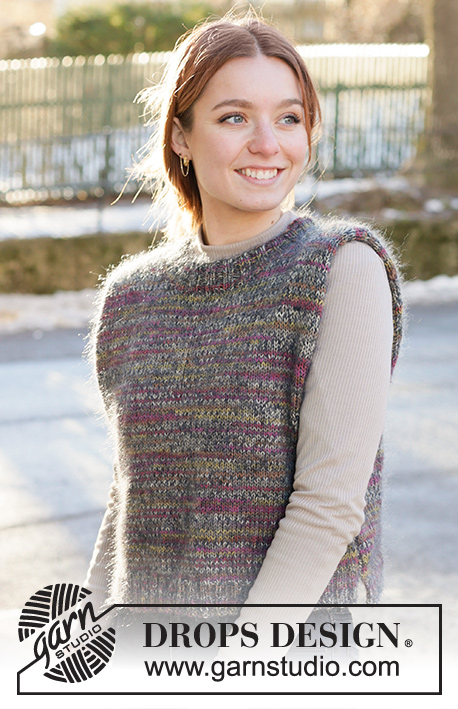 |
Knitted vest in 1 strand DROPS Fabel and 1 strand Kid-Silk. The piece is worked bottom up with diagonal shoulders. Sizes S - XXXL.
DROPS 237-42 |
|
|
------------------------------------------------------- EXPLANATIONS FOR THE PATTERN: ------------------------------------------------------- RIDGE/GARTER STITCH (worked back and forth): Knit all rows. 1 ridge = knit 2 rows. ------------------------------------------------------- START THE PIECE HERE: ------------------------------------------------------- VEST – SHORT OVERVIEW OF THE PIECE: The front and back pieces are worked separately back and forth, bottom up. The back piece is 2 cm longer than the front. The sleeve-edges and neck are worked in the round to finish. BACK PIECE: Cast on 88-96-104-112-120-132 stitches with circular needle size 4 mm and 1 strand DROPS Fabel and 1 strand DROPS Kid-Silk (2 strands). Purl 1 row from the wrong side. Work rib from the right side as follows: 1 stitch in GARTER STITCH – read description above, work rib (knit 2, purl 2) until there are 3 stitches left, knit 2 and 1 stitch in garter stitch. Continue this rib for 4 cm. Change to circular needle size 5 mm. Continue with stocking stitch; on the first row decrease 14-14-16-16-14-16 stitches evenly spaced = 74-82-88-96-106-116 stitches. Work until the piece measures 19-20-21-22-23-24 cm. REMEMBER THE KNITTING TENSION! On the next row begin to cast off for the armholes on both sides: 3-3-3-4-4-4 stitches 1 time, 2 stitches 1 time and 1 stitch 1-3-4-6-9-12 times = 62-66-70-72-76-80 stitches. Continue working until the piece measures 42-44-46-48-50-52 cm (4 cm left to finished length). On the next row cast off the middle 26-26-28-28-30-30 stitches for the neck and finish each shoulder separately. OVERVIEW OF THE NEXT SECTION: You now cast off for the neck and place stitches on a thread for the diagonal shoulder. Read NECK and DIAGONAL SHOULDER before continuing. NECK: Cast off 1 stitch at the beginning of the next row from the neck. DIAGONAL SHOULDER: Place the stitches towards the armhole on a thread; to avoid having to cut the strand, work the stitches first. Place 4-5-5-5-6-6 stitches on the thread 3 times then the remaining 5-4-5-6-4-6 stitches. All stitches are now either cast off or on the thread. Place the 17-19-20-21-22-24 stitches from the thread back on circular needle size 5 mm. Purl 1 row from the wrong side. To avoid holes where you turned, pick up the strand between 2 stitches and purl it twisted together with the next stitch on the left needle. Cast off with knit, a little loosely, from the right side. The piece measures approx. 46-48-50-52-54-56 cm from the cast-on edge to the highest point on the shoulder. Work the other shoulder in the same way. FRONT PIECE: Cast on and work as the back until the front piece measures 17-18-19-20-21-22 cm. On the next row begin to cast off for the armholes on both sides: 3-3-3-4-4-4 stitches 1 time, 2 stitches 1 time and 1 stitch 1-3-4-6-9-12 times = 62-66-70-72-76-80 stitches. Continue working until the piece measures 34-36-36-38-38-40 cm (approx. 10-10-12-12-14-14 cm left to finished length). On the next row from the right side place the middle 12-12-14-14-16-16 stitches on a thread for the neck and finish each shoulder separately. OVERVIEW OF THE NEXT SECTION: You now cast off for the neck and place stitches on a thread for the diagonal shoulder. Read NECK and DIAGONAL SHOULDER before continuing. NECK: Cast off from the neck 2 stitches 2 times and 1 stitch 4 times. DIAGONAL SHOULDER: AT THE SAME TIME, when the piece measures 41-43-45-47-49-51 cm place the stitches towards the armhole on a thread in the same way as on the back piece. When all the stitches are either cast off or on the thread, place the 17-19-20-21-22-24 stitches from the thread back on circular needle size 5 mm. Purl 1 row from the wrong side in the same way as on the back. Cast off a little loosely with knit from the right side. The piece measures approx. 44-46-48-50-52-54 cm from the cast-on edge to the highest point on the shoulder. Work the other shoulder in the same way. ASSEMBLY: Sew the shoulder seams edge to edge. Sew the side seams edge to edge, starting from the armholes and sewing to 1 cm after the beginning of the rib, leaving a split; the back piece is longer than the front. NECK: Start from the right side on one shoulder, with 1 strand Fabel and 1 strand Kid-Silk. Using short circular needle size 4 mm knit up 80 to 100 stitches (including the stitches on the thread) around the neck. Stich-number should be divisible by 4. Work rib in the round (knit 2, purl 2) for 4 cm. Cast off with knit over knit and purl over purl. SLEEVE-EDGES: Start from the right side at the bottom of the armhole with 1 strand Fabel and 1 strand Kid-Silk. Using short circular needle size 4 mm knit up 112 to 136 stitches around the armhole (Stich-number should be divisible by 4). Work rib in the round (knit 2, purl 2) for 4 cm. Cast off with knit over knit and purl over purl. Work the other sleeve-edge in the same way. The edge can be folded double to the inside for a narrower but thicker sleeve-edge. |
|

|
|
|
Have you made this or any other of our designs? Tag your pictures in social media with #dropsdesign so we can see them! Do you need help with this pattern?You'll find tutorial videos, a Comments/Questions area and more by visiting the pattern on garnstudio.com. © 1982-2024 DROPS Design A/S. We reserve all rights. This document, including all its sub-sections, has copyrights. Read more about what you can do with our patterns at the bottom of each pattern on our site. |
|
With over 40 years in knitting and crochet design, DROPS Design offers one of the most extensive collections of free patterns on the internet - translated to 17 languages. As of today we count 304 catalogues and 11422 patterns - 11422 of which are translated into English (UK/cm).
We work hard to bring you the best knitting and crochet have to offer, inspiration and advice as well as great quality yarns at incredible prices! Would you like to use our patterns for other than personal use? You can read what you are allowed to do in the Copyright text at the bottom of all our patterns. Happy crafting!







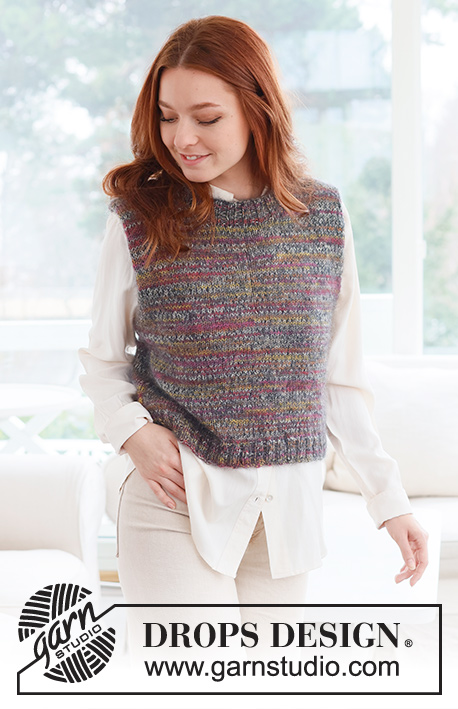

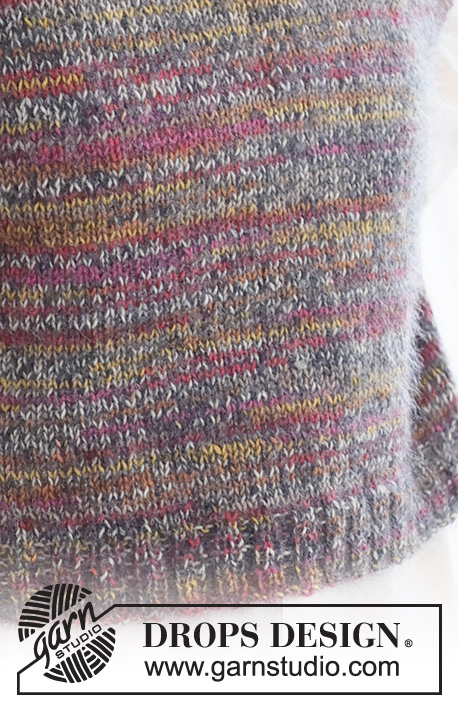


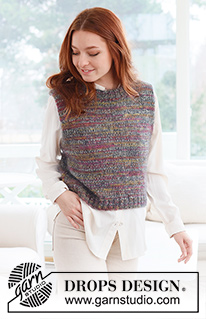
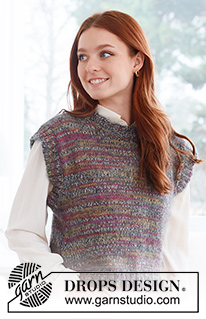
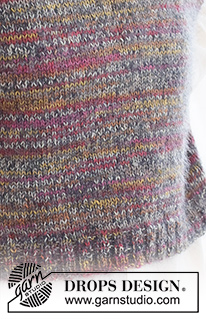









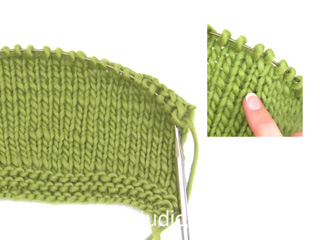











































Comments / Questions (26)
Quanta lana mi occorre per fare il gilet Fairytale con Fabel 330 e 2 colori Kid Silk 16 e 17 per la mia taglia 48 Grazie per la Vs; cortesia e per il Vs bellissimo sito
15.03.2024 - 17:29DROPS Design answered:
Buonasera Lina, per trovare la taglia corretta può seguire lo schema per le taglie in fondo alla pagina del modello. Buon lavoro!
16.03.2024 - 18:53Ich habe eine grundsätzliche Frage zur Maschenzahl. Nach Strickmuster für Größe M: Breite des Vorder- und Rückenteils 48 cm. Anschlag jeweils 96 Maschen. Da die Maschenprobe mit 5er Nadeln 17 Maschen = 10 cm ergibt, kann ich nicht verstehen, wie es zu 96 Maschen kommt, um eine Weite von 48 cm zu erreichen. 17 x 4.8 = 81,6, also 82 Maschen oder vielleicht ein paar mehr, aber doch nicht 14 extra = ca. 8cm? Verstehe ich etwas falsch? Danke für eine Erklärung
02.02.2024 - 17:37DROPS Design answered:
Liebe Brigitte, für dieselbe Breite braucht man mehr Maschen für Bündchen mit den Nadeln Nr 4 als mit für Glattrechts mit den Nadeln Nr 5 , deshalb werden zuerst mehr Maschen für das Bündchen angeschlagen, dann Maschen abgenommen für die Nadeln Nr 5 = 82 Maschen mit 17 Maschenproben sind ca 48 cm breit. Viel Spaß beim stricken!
05.02.2024 - 07:55Hej. Under “forklaring til opskriften” står der, at der skal strikkes i retstrik (ret på alle pinde). Længere nede står der så glatstrik. Ud fra opskriften lyder det som om, det er glatstrik hele vejen (på nær ved ribstrik). Er det en fejl?
30.01.2024 - 18:18DROPS Design answered:
Hei Mona. Det er bare kantmaskene som skal strikkes i RETSTRIKK. Altså når du strikker vrangborden skal den strikkes slik: 1 maske RETSTRIK, strik rib (2 ret / 2 vrang) til der er 3 masker tilbage, strik 2 ret, 1 maske RETSTRIK. Selve vesten strikkes i glattstrikk, slik du ser på bildet. mvh DROPS Design
05.02.2024 - 14:10Jag har maskat av de mittersta 26 maskorna och har nu axlarna kvar på stickorna som jag ska börja med. Förstår inte riktigt vad som menas med ”Minska 1 maska till hals i början av nästa varv från halsen”. Är det från avigsidan på ena axeln?
01.01.2024 - 23:09DROPS Design answered:
Hej Madeleine, ja på ditt högra framstycke minskar du från rätsidan och vänster framstycke minskar du från avigsidan vid att sticka ihop de 2 första maskorna :)
03.01.2024 - 08:01I am having difficulty understanding the diagonal shoulder. Is it possible to knit to knit plain shoulder straps?
21.11.2023 - 03:47DROPS Design answered:
Dear Mrs Benningen, you could but your measurements might be then different as the one in the chart; diagonal shoulders are just short rows: you slip the first stitches at the beg of a row from shoulder towards neck on a thread on every other row until all stitches are slipped aside (at the same time bind off for neck as explained for your size), then work all stitches and bind off on net row. Happy knitting!
21.11.2023 - 08:59Bonjour , Je ne comprends pas ce passage « COL: En commençant sur l’endroit à une des épaules, relever, avec la petite aiguille circulaire 4, 80 à 100 mailles (y compris les mailles en attente) autour de l’encolure. » ? : En commençant la relève des mailles à une épaule avec un nouveau fil, que faire de ce fil lorsque j’arrive aux 14 mailles qui sont en attente ? Merci d’avance pour votre réponse :)
04.11.2023 - 00:15DROPS Design answered:
Bonjour Virginie, effectivement, vous commencez à relever les mailles au niveau de la couture d l'une des épaules, puis vous relevez des mailles jusqu'à vos 14 mailles en attente, vous tricotez ces 14 mailles à l'endroit et vous continuez à relever les mailles autour de l'encolure jusqu'au début du tour. Si votre. nombre de mailles n'est pas divisible par 4 lorsque vous relevez les mailles, diminuez/augmentez à intervalles réguliers au 1er tour de côtes. Bon tricot!
06.11.2023 - 08:06Bonjour, je ne comprends pas ce que signifie tricoter “ une maille au point mousse” au tout début du tricot. Il ne faut pas juste faire des côtes 2/2 sur 4 cm ?
23.10.2023 - 15:38DROPS Design answered:
Bonjour Juliette, vous tricotez bien en côtes pour le bas du dos/devant mais avec 1 maille lisière au point mousse de chaque côté, autrement dit, tricotez à l'endroit la 1ère maille et la dernière maille de chaque rang (sur l'endroit mais aussi sur l'envers). Bon tricot!
24.10.2023 - 08:47Bonjour, - j’ai une question concernant ce passage «Placer en attente 3 fois 4 mailles puis les 5 dernières mailles ». Pourquoi il faut les placer séparément ? je peux mettre mes 17 mailles sur un arrête maille directement non? - je ne comprends pas ce qu’il faut faire ici non plus : « relever le fil entre 2 mailles et le tricoter ensemble torse à l’envers » Merci bcp !
20.10.2023 - 15:09DROPS Design answered:
BonjourJuliette, on tricote des rangs raccourcis pour former un biais au niveau des épaules: on a ainsi plus de rangs côté encolure que côté emmanchure - dans cette vidéo, on montre (pour un autre modèle) comment procéder. Pour éviter des trous entre les mailles en attente, relevez le fil au niveau où vous avez tourné, et tricotez le torse avec la maille suivante pour éviter un trou. Bon tricot!
20.10.2023 - 16:03Et ducoup il faut rabattre 2 fois, cad une m au niveau de chaque épaule? et il y a écrit qu'il faut 'finir les épaules séparément' mais je ne comprends pas comment faire parceque après avoir fait l'étape de l'encolure ça veut dire qu'on reste sur une épaule et on continu de tricoter et après on fait pareil sur l'autre je suppose ? et après il y a écrit 'rabattre souplement' ça veut dire qu'il faut rabattre toutes les mailles sur les 2 chaque épaule pour les finir quoi ?
20.10.2023 - 13:15DROPS Design answered:
Bonjour Juliette, quand vous avez rabattu les mailles de l'encolure dos, vous terminez les 2 épaules l'une après l'autre, rabattez sur l'endroit, mettez les mailles de l'épaule droite en attente et terminez l'épaule gauche: en début de rang sur l'envers, tricotez les premières mailles pour les mettre en attente, et rabattez 1 maille au début du 1er rang à partir de l'encolure (=sur l'endroit pour l'épaule gauche du dos), terminez l'épaule gauche comme indiqué, puis coupez le fil, et tricotez l'épaule droite de la même façon. Bon tricot!
20.10.2023 - 14:20Bonjour, je ne comprends pas ce passage: POUR le dos il y a écrit "au rang suivant, rabattre les 26m centrales pour l’encolure" et après pour l'encolure il faut "rabattre une maille au début du rang suivant". Ça veut dire qu'après avoir rabattu les 26m centrales, il faut finir le rang (donc l'épaule) et ensuite refaire un rang (que l'épaule) et rabattre une maille dans ce nouveau rang ? et si c'est le cas c'est à quelle m qu'on rabat ? à la dernièrère du rang ? (1)
20.10.2023 - 13:01DROPS Design answered:
Bonjour Juliette, c'est tout à fait ça, on doit rabattre 1 maille pour l'encolure et on ne peut rabattre qu'en début de rang, donc on va rabattre 1 maille en début de rang sur l'endroit pour l'épaule gauche du dos et 1 maille en début de rang sur l'envers pour l'épaule droite du dos. Bon tricot!
20.10.2023 - 14:14